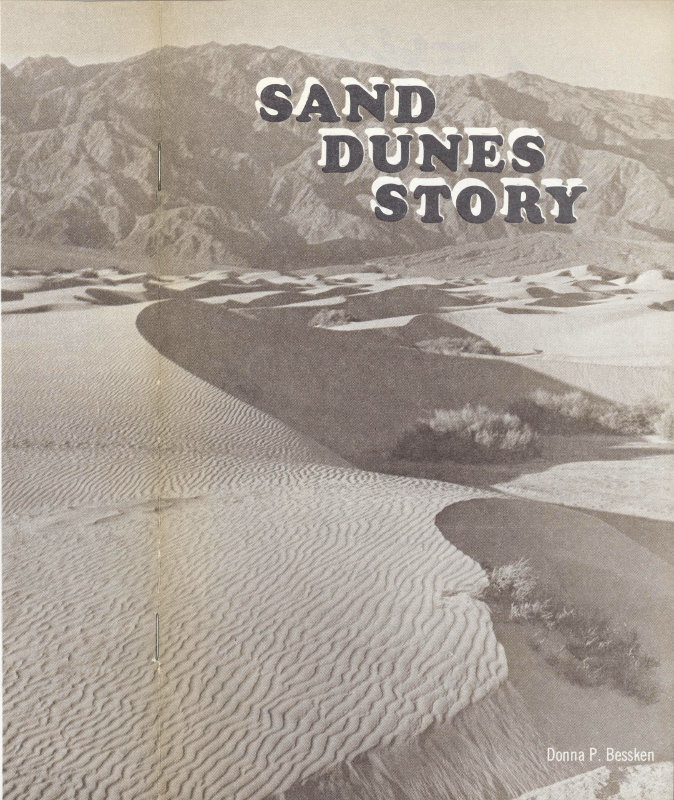

DONNA P. BESSKEN

What do YOU see as YOU look across the dunes? Piles of lifeless sand? A giant sandbox? Each of us sees the dunes differently. We would like to share the story of the Death Valley Sand Dunes with you. This booklet provides answers to some of your questions about the origin, composition and formation of the dunes. We will also look at the plants, and for evidence of animals that make their home here.
The features discussed are near the edge of the dunes and all you need is your curiosity to explore this fascinating place. A magnifying glass or magnet may add to your enjoyment. Remember—the dunes can be hot in spring and fall as well as in summer months. Be sure to carry water, distance is deceiving, and a short stroll may become an extended walk. Do you want to walk barefoot? Be careful around the bushes; thorns and plant debris are hidden in the sand. Carry your shoes, your feet may get tired, or the sand may become too hot. When you are in the shade, look around to see if other creatures are sharing the same cool place. This is home for such desert dwellers as lizards, kangaroo rats and sidewinders.
There is no guided trail since wind can soon cover a trail with sand. It’s easy to find your way around and can be fun to choose your own route. Look behind you to get firmly in your mind which mountain feature will be your landmark to guide you back to your vehicle.
To make the best use of this booklet, flip through it to locate topics of interest. Read in sequence, or follow the order of your discoveries. Use your senses to appreciate and explore the sand dunes more fully. Pick up some sand occasionally and compare the texture, temperature and other qualities to that found in other locations. Be alert for little things—notice plants, sand ripples, animal burrows and tracks.
Let’s walk into the dunes a short distance and learn their secrets. To form sand dunes, three things are needed: wind, sand, and a place for the sand to collect. The story of the dunes involves interaction among these factors and the plants and animals that make their homes in this sea of sand.
Are they limited to this section of the valley? Do they migrate? Answers to these questions are in the winds.

Significant seasonal variations in wind patterns affect the dunes.
Winter and summer bring winds from different directions; northerly in winter and southerly in summer. Landforms influence crosswinds and swirling wind currents (eddies). These crosswind and eddy patterns result in decreased wind speed and cause the sand to drop out in the same general area time after time. Seasonal variations in wind direction help keep the sand in one area.
Between individual dunes, white salt deposits are often seen on the surface of an old clay lakebed (playa). Here too, we see how tall the dunes are because the sand is piled entirely on top of this playa. Infrequent rains produce changes in the playa surface, and occasionally gravel is washed into the area from nearby mountains. Because of the clay content of the soil, rain water does not soak in quickly, but lies in pools. As the pools evaporate, fresh deposits of salts and minerals remain on the surface. Similar salt deposits throughout the valley to the south minimize the amount of available blowing sand by cementing it together.
Dunes in Death Valley consist of sand from local materials found in nearby mountains. The primary source of this sand is believed to be the Cottonwood Mountains to the west and northwest. Although the shapes and patterns of individual dunes may vary daily or seasonally, the dune field itself is relatively stable.

Pick up some sand! Is it fine or coarse? Wet or dry? Warm or cold? Notice the different colors. A magnet may help you separate particles, and a magnifying glass will allow you to examine them more closely. Most black particles are magnetite—most white ones are quartz. Other minerals provide still different colors. The sand here is a product of weathering by wind, rain and chemical changes—breaking blocks of rock (primarily granite) from nearby mountains into particles small and light enough to be carried by run-off and tossed around in the frequent desert winds.
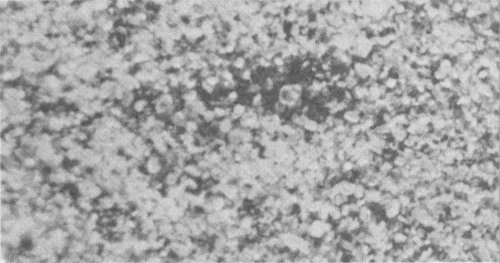
Take a close look at sand grains.
Each wind produces changes to the surface of the sand. It takes a 10 mph (16 kph) wind to move fine, dry sand. During a sandstorm, it may seem as if the sand is blowing thousands of feet into the air. Your view of the distant mountains may be obscured. Don’t be fooled! The dunes are not entirely airborne! What you see are dust particles being carried aloft because they are smaller and lighter than sand grains. Seldom does dune-sized sand itself rise more than 6 ft. (2 m) above the ground, it is too heavy.
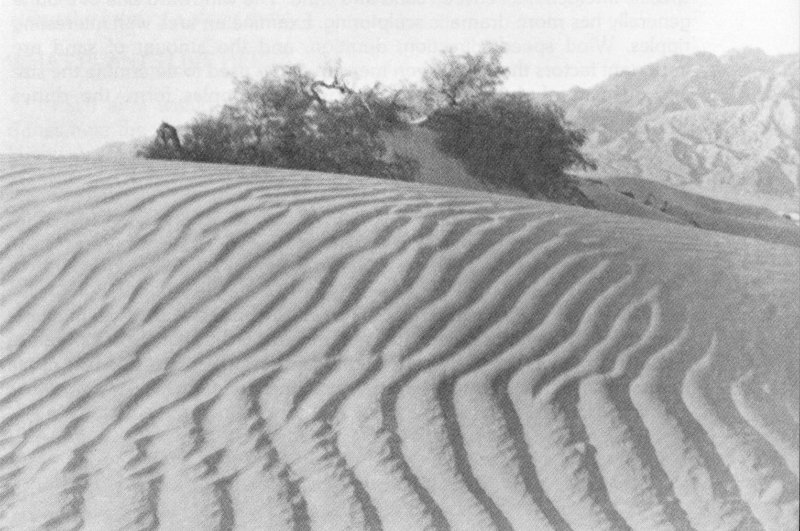

Actually, most sand travels within about 18 in. (46 cm) of the ground in a jumping movement called saltation. A windborne grain bounces a short distance before crashing into the sandy surface sending other grains into flight. The process continues as the wind carries the new grains a little farther, crashing them, in turn, into the surface and other grains along the way. Sand grains too heavy to blow in the wind creep along the surface of the sand, while smaller ones are truly airborne above the dunes. As a consequence, the entire sand surface flows or creeps along.
Have you been comparing the texture, size and color of sand in various sections of the dunes? Some differences will be more obvious if you have the chance to visit both the tall dunes by Highway 190 and the low ones by the picnic area. The soft, fine sand by the picnic area is carried farther by the wind than the coarser material found in the taller dunes.
Smaller grains move farther than large ones. As a result of this sorting of sand grains by variable winds, the larger grains accumulate in small ridges forming ripples. Size and shape of these formations are related to specific interactions between sand and wind. The windward side of a dune generally has more dramatic sculpturing. Examine an area with interesting ripples. Wind speed, direction, duration, and the amount of sand are important factors that have been measured and used to determine the size and spacing of dune ripples. Just as these ripples form, the dunes themselves respond to changes in each of these factors.
| { Speed | { Size | ||
| WIND | { Duration | + SAND | { Uniformity = RIPPLE FORMATION |
| { Direction | { Amount |

All dunes may be described by the above traits. Variations in shape and size of individual dunes are determined by the mathematical values applied to each of the traits mentioned in the discussion of ripple formation. Another feature of interest is the dune shape. Among these 7 dunes you may find examples of this classic textbook model and its variations.

Plants on the playa in between the dunes
Note that the downwind side of the dune, the slipface, is the steeper one. Fine dry sand can only pile up so high before it breaks away and slides down the slipface as an avalanche to rest at the more stable angle of repose, about 34 degrees. We create miniature avalanches as we walk along the crest of a steep dune.
Each area within the dunes has something different to offer. Low dunes near the picnic area have more vegetation than the tall dunes near Highway 190.
Plants, visible from the top of many dunes, help the dunes remain here by stabilizing the sand with their branches and roots. You will see different plants, depending on whether you are in the tall or low dunes. You may find them in a different sequence from that used in this booklet. By looking for different shades of green, you should find each of the major shrubs and trees that live in the dunes. Use the diagrams and photos to help identify those you see. Let’s take a closer look to learn how they survive and how they relate to the story of the dunes.
Can you find a low bush which appears to have no leaves? The stems are jointed and succulent (juicy) and vary in color from yellowish to bright green, depending on the season. Pickleweed (Allenrolfea occidentalis), is often found on top of low mounds of sand. Do the stems look like tiny pickles joined end-to-end? During summer months, tiny, inconspicuous, yellow flowers may be seen at the joints. With a magnifying glass, you may see the miniature leaves.

PICKLEWEED
(Allenrolfea occidentalis)
By reducing leaf size, the plant minimizes surface through which water can be lost. Green stems assume the task of photosynthesis, normally done by leaves, providing food for the plant of this arid environment.
Although the sand does not often appear wet, pickleweed suggests water is not far below the surface. It requires a wet soil and can grow in very salty areas. Watch for pickleweed near Badwater also.
Find a different shrub, gently rub a leaf and smell it. Does it smell faintly like fish? Look at the leaf you have just rubbed. Did the surface dust rub off to reveal a deeper shade of green? Does it have fleshy leaves? If so, you have found the inkweed (Suaeda torryana). If your shrub has a less noticeable smell, and perhaps rubber-like texture, and if you did not easily remove the white chalky coating from the light gray green leaves, it is saltbush. If your shrub has numerous tiny spines, be careful, you may have found a Russian thistle (Salsola kali) or tumbleweed, as it is also called. They are not native to Death Valley, but have become established in certain areas.
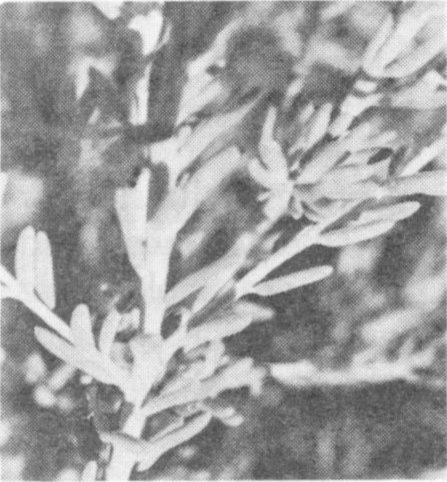
INKWEED
(Suaeda torryana)
Inkweed’s young succulent leaves and seeds were used for food by local Shoshoni Indians. Stems and leaves were processed to make a black dye. You may notice tiny balls of seeds at the very ends of some branches. The green flowers are very inconspicuous.
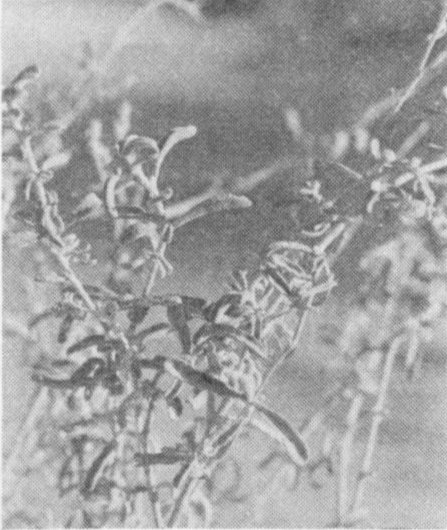
FOUR-WING SALTBUSH
(Atriplex canescens)
Saltbush is light green and its dry, flat leaves are covered with salt. Roots remove salts from the soil and water, then the salt is deposited on the outer surface of the leaves. Consequently, the whitened leaf surfaces reflect sunlight, thereby reducing temperature and water loss. There are male and female saltbushes. You may want to search for seeds or flowers. Seeds on female bushes have four tiny wings which give it the name—four-wing saltbush (Atriplex canescens). Seeds were used as food by Shoshoni Indians.
On your way into the dunes did you notice any other plants? If not, watch for them as you return to your vehicle. Remember, the kinds of plants vary depending on your location in the dunes. The clumps of grass near the picnic tables are alkali sacaton 9 (Sporobolis airoides). Approaching the tall dunes you may have seen large plants with small, shiny, smooth, dark green leaves—the creosote bush (Larrea tridentata). It has small yellow flowers, usually observed in springtime. Later, small, fuzzy, white balls containing seeds grow on its branches. The larger green or brown, walnut shaped growths on the branches are galls formed in response to an insect invader (midge). If you missed creosote bushes in the dunes, watch for them along the roadsides—they are common.
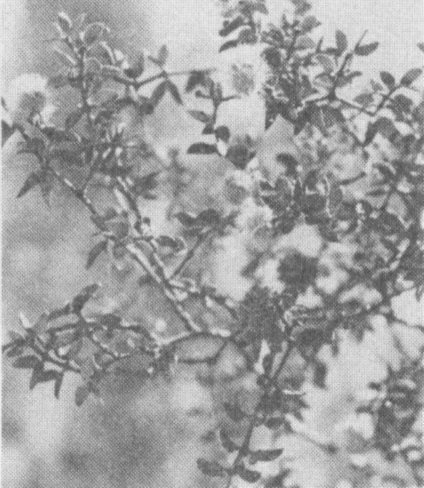
CREOSOTE BUSH
(Larrea tridentata)
Although the sand dunes seem dry, there is an underground reservoir providing moisture and nutrients for vegetation. The crusty mud playa acts as a cap and reduces evaporation of the underground water supply. Nearby, at Salt Creek, the same water flows on the surface as a stream during the winter and spring.
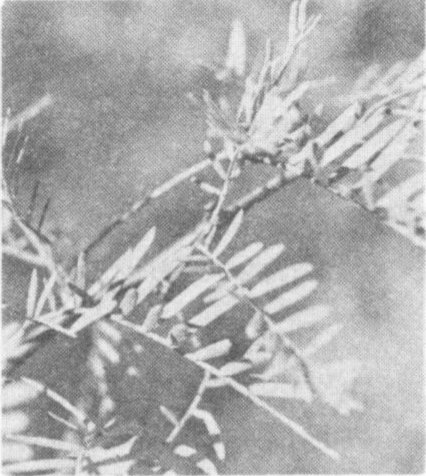
MESQUITE
(Prosopis glandulosa)
Most plants grow in the hollows between the dunes where they receive some protection from the wind and can reach water more easily. Yet, the mesquite tree (Prosopis glandulosa), probably the largest plant in sight, is often on top of the dunes. By slowing the wind with its branches, the mesquite causes sand to pile up in mounds beneath it. Sometimes sand completely covers a part of the tree causing branches to die. The sand then blows away, exposing those dead branches. Look for an example which illustrates this sand movement. Mesquite trees have thorns, so be careful. The mesquite tree loses its small, delicate leaves during winter. Its deep root system, growing 50-60 ft. (16-20 m) into the ground to reach fresh water, helps the tree survive. Some plants, such as saltbush, pickleweed, and mesquite seem incompatible because of different mineral and water requirements. However, these plants are able to live near each other because their roots are drawing moisture and nutrients from different levels of the soil. For example, in a rain forest, where the roots have ample water, most plant growth is above ground where competition is for sunlight. Whereas in a desert, where sunlight is abundant, competition for water is more critical. The root system of desert plants are highly developed, and each plant will find the optimum level in the soil suitable for its growth.

Mesquite tree: sand collector, food and shelter for animals and Shoshoni.
Be careful not to trample the roots as you explore the mound of sand near the mesquite tree—you may collapse a burrow—remember, you and the animals may be sharing the same shade.
Mesquite trees are also special in that they produce an edible and nutritious fruit. In late spring, tiny, yellow flower spikes hang from the branches. These develop into yellow bean pods by late summer. Many different animals use the beans for food. Mesquite beans were also a major food source for the Shoshoni.
Shoshoni Indians have lived in Death Valley for many years—migrating to the mountains for the hot summer months and returning to the valley for the winter. Their movements were related to supplies of food and water and influence of temperature. It is more likely that areas such as these sand dunes were visited for food gathering rather than as a place of residence. To survive in the desert, the Shoshoni had to learn which plants to eat, where they grew and when to harvest them. They also learned which animals were reliable food sources—where they could be found in abundance and when they were active.
Use your imagination—how well could you survive in this wild area? Where and how would you find water? Which plants and animals would you eat?
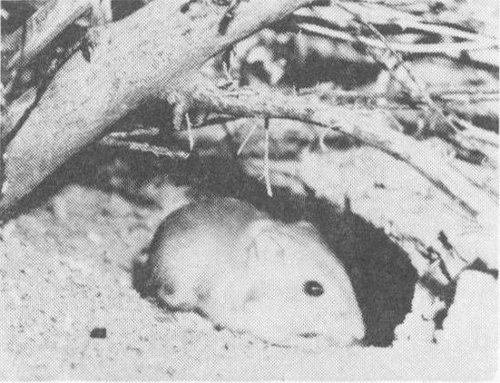
KANGAROO RAT
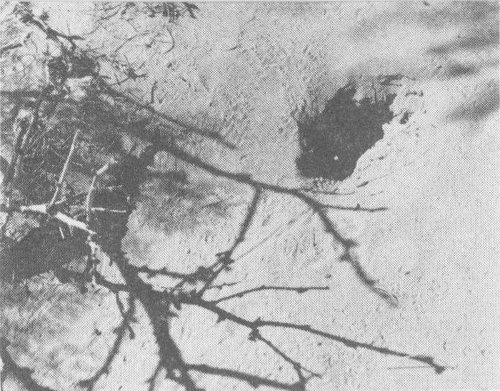
BURROW
Guess which animal lives in which hole! How large is the entrance? The size of the entrance suggests the size of the animal. How many other openings are nearby? Often escape exits save rodents from predators. Are there recent tracks nearby to indicate it is an active burrow, or is it covered with sand and debris blown in by the wind?
Inside these burrows the temperature and living conditions are not as extreme as those on the surface of the sand. Try digging a small hole in the sand well away from bushes. How soon does the sand change as you dig? Is it warmer or cooler or wetter? Beneath the surface the moderate temperatures and increased moisture provide an escape from the intense heat. Consequently, dune residents spend the day in their dens and are active at night.
Kangaroo rats, for example, cannot tolerate heat and escape it by living underground. Also they are active only at night. They are very efficient water conservationists. Although water is essential to the kangaroo rat, they rarely drink, but produce their own water from insects and dry seeds they eat. They have no sweat glands, and excrete highly concentrated wastes to minimize water loss.
These rodents are not related to kangaroos at all! Their name refers to their hind legs which are highly developed for jumping.
Watch for their tracks—when a kangaroo rat is moving slowly, it drags its tail which leaves a trail in the sand in conjunction with its foot prints. When the rat moves quickly, its tail doesn’t drag. From clues such as these we can determine whether the rat is running from a predator or just leisurely looking for food. The entrances to their burrows are about 4-5 in. (10-12 cm) in diameter and may be 3 ft. (1 m) or more deep. Smaller rodents, such as pocket mice, have similar habits but live in smaller burrows.
Lizards are more active during daylight hours. Even though they tolerate higher temperatures than rodents, they would perish if they were 12 stranded in the open sun for an extended period of time. Notice how they run from bush to bush, seeking the protective coolness as well as cover. Lizards are cold-blooded animals, responding to temperatures around them—cold, inactive—warm, active. In the winter months, there is very little lizard activity. However, summer days with ground temperatures reaching 200 degrees F. (92 degrees C.) or more are too hot for lizards, and they must seek shelter. They eat plant material, insects and smaller lizards, obtaining moisture from their food. They also conserve water by excreting highly concentrated waste.

LIZARDS
Perhaps least observed, but most inquired about dunes dweller, is the sidewinder. Have you seen evidence of this rattlesnake today? It moves in a sidewise manner leaving a series of parallel, J-shaped tracks in the sand.
By looping across the sand, the sidewinder reduces slippage over the loose material and decreases the amount of body surface in contact with the hot sand. Sidewinders are primarily active at night, and escape the heat of the day under a bush or buried in the sand, exposing only the small horn-like structures on their heads. They eat kangaroo rats, mice and lizards.
Imagine the dunes as an ocean where all the sand is water and plants are islands scattered about. Each island offers shelter and a food supply for the animals. Everytime an animal leaves the security of an island it takes a risk. In daylight, people may play in the sand, but at night the dunes come alive with the real business of survival. Usually all we see of this activity the following morning is the evidence—tracks. Some tracks are easily identified—each tells a story. Use the diagrams to determine which animals most recently crossed the sea of sand around you.
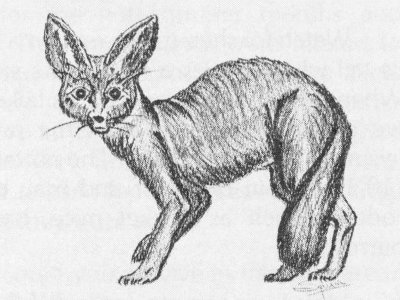
KIT FOX
Coyotes come into the dunes for food. True opportunists, they eat whatever is available—mice, kangaroo rats, rabbits, insects, mesquite beans and many other things. Their tracks are difficult to distinguish from those left by domestic dogs. Smaller dog-like tracks are left by the kit fox. These small foxes have large ears and well padded feet. They too feed on small rodents. Coyotes and kit foxes receive moisture from their food and drink water at springs within their hunting range. They avoid exposure to heat by being active at night and staying in dens or shaded areas during the heat of the day.
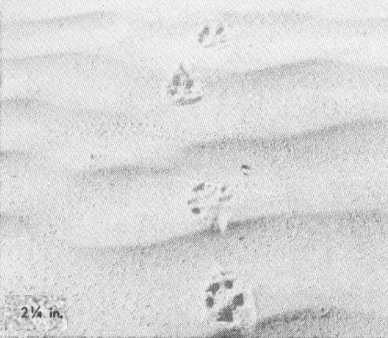
COYOTE
2¼ in.
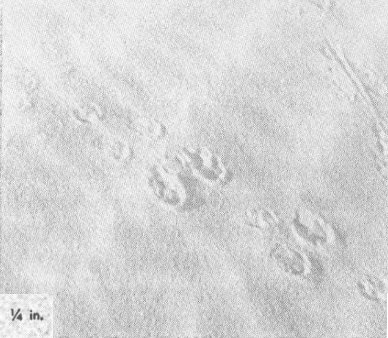
KANGAROO RAT
¼ in.
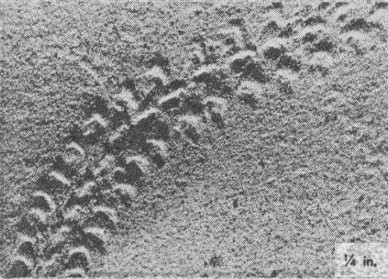
BEETLE
¼ in.
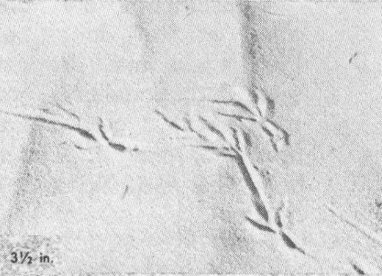
RAVEN
3½ in.
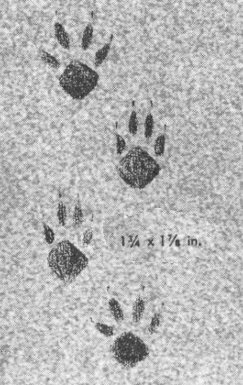
KIT FOX
1¾ × 1⅞ in.
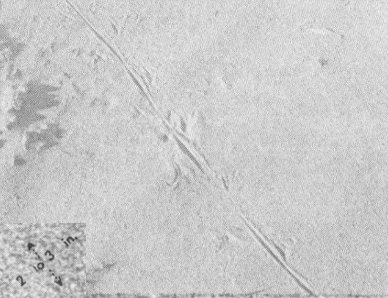
LIZARD
2 to 3 in.
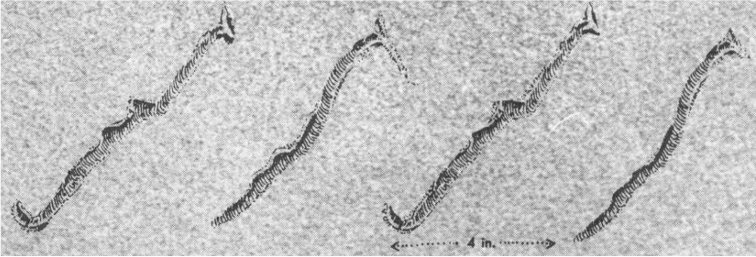
SIDEWINDER
4 in.

JACKRABBIT
Jackrabbits are not seen often in the dunes, although their tracks and droppings are seen occasionally. They feed on plants, getting moisture from their food rather than from distant springs. Large ears radiate excess body heat and help cool the animal as it rests in shaded areas during the hot day.
Have you seen any birds? Birds also leave tracks! The large bird tracks here are generally left by ravens—big, black birds which eat almost anything. In the spring and fall, some migrating birds stop briefly. Shrikes, sparrows, kingbirds and blackbirds are among the visitors and residents of the dunes. Insects and vegetation provide food and shelter for them.
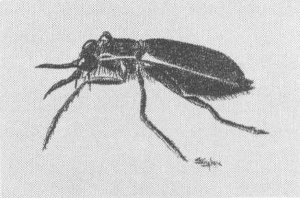
BEETLE
Have you seen any insects? Tracks resembling those of a tiny bulldozer tell us where beetles have traveled. Shiny black circus beetles or stinkbugs and gray snout beetles are often seen.
Since most activity in the dunes takes place at night, very little of this action is observed. However, in the morning we can stroll in the sand and unravel the secrets of the previous night. As you look at each set of tracks, imagine what the animal looks like as it moves. How big is it? How many feet does it have? Are the feet side by side as though jumping like rodents or rabbits, or do they alternate as in the walking or running motion of lizards? How far apart are the prints? Does the animal drag its tail? Now, where do the tracks go? Follow some animal tracks to see what interactions have taken place. The same animal may leave different tracks on different sand surfaces or under difference circumstances. Notice your own tracks as you walk, run, jump or sit in loose or firm sand. Try it!
In many respects these dunes are like any Other deposits of windblown sand along the coast or in deserts. They reflect variations in the sand supply and respond to particular wind patterns following the same basic, natural principles. Several other National Parks and Monuments have sand dunes of various sizes and composition. Death Valley dunes are not the largest in the United States by any means! Here the dunes reach a height of 80 ft. (24 m). They provide a visual change of pace with their soft lines and shadows in contrast to the sharp, rugged mountain peaks around them.
Sand
soft
fine
Easy to sift and mold.
Once a solid block of rock now weathered very old.
Blown by winds into dunes and features.
Forming a hot dry home for desert creatures.
Patterns of shadow and shade by tree and sand dune made.
Walk
touch
explore
Enjoy the dunes and come back once more.
Donna Paul Bessken
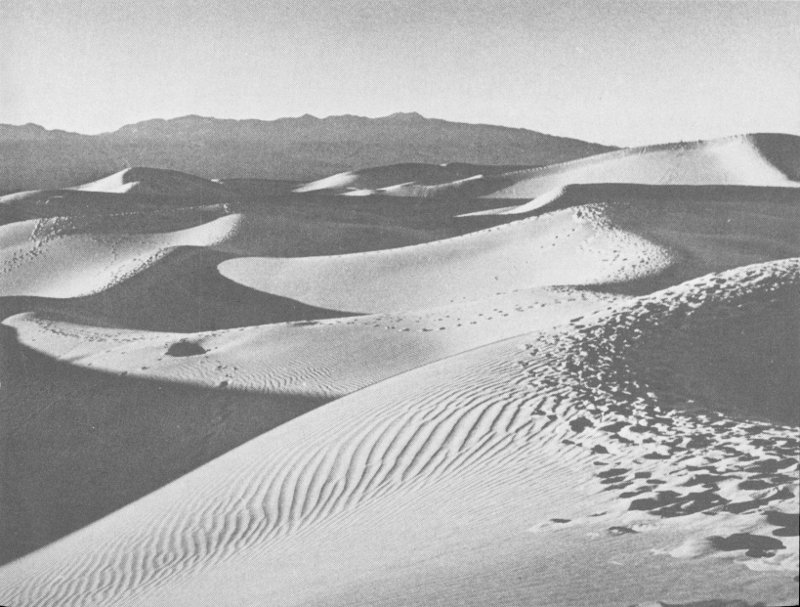
We hope you have enjoyed this walking tour. As you continue to explore Death Valley National Monument, contact any National Park Service employee if you need information or assistance.
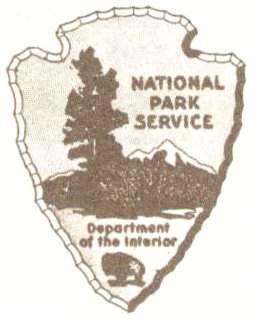
U. S. DEPARTMENT OF THE INTERIOR
National Park Service
As the Nation’s principal conservation agency, the Department of the Interior has basic responsibilities for water, fish, wildlife, mineral, land, park and recreational resources. Indian and territorial affairs are other major concerns of America’s “Department of Natural Resources.” The Department works to assure the wisest choice in managing all our resources so each will make its full contribution to a better United States—now and in the future.
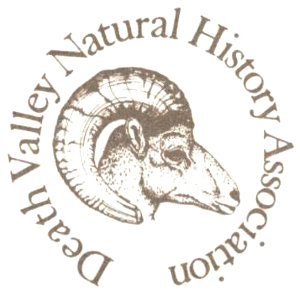
The Death Valley Natural History Association is a non-profit organization pledged to aid in the preservation and interpretation of the outstanding features of Death Valley National Monument.
FOR INFORMATION AND MEMBERSHIP CONTACT
Death Valley
Natural History Association
P.O. Box 188
Death Valley, California 92328
